

This webpage won't be updated anylonger.
Please visit: www.gerhardsengerner.com
Vibeke Tandberg – A piece of me (2008)
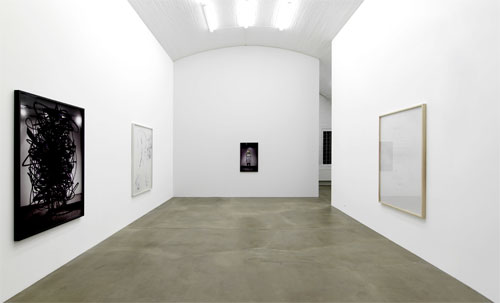
Installation view, c/o – Atle Gerhardsen
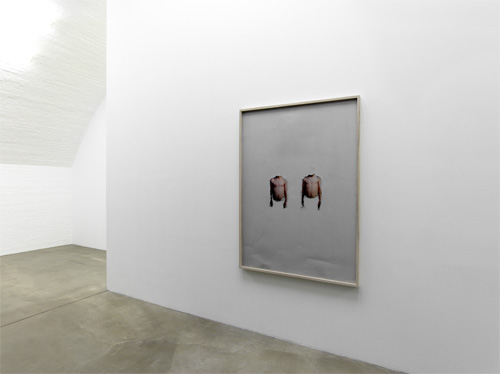
Installation view, c/o – Atle Gerhardsen
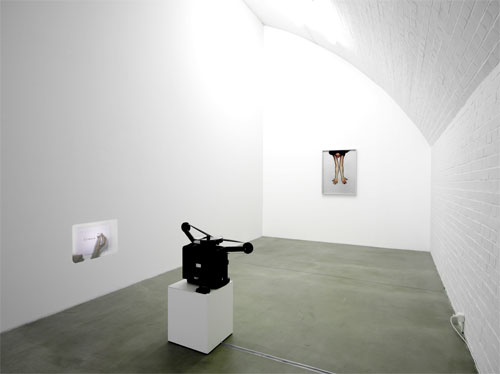
Installation view, c/o – Atle Gerhardsen

Untitled (Britney), 2008
Lightjet print, B/W, black marker, colour pigment print, acrylic glue
112 x 72,4 cm framed, Unique

Untitled (Scribble), 2008
Lightjet print, B/W
179,8 x 123,5 cm framed, Unique
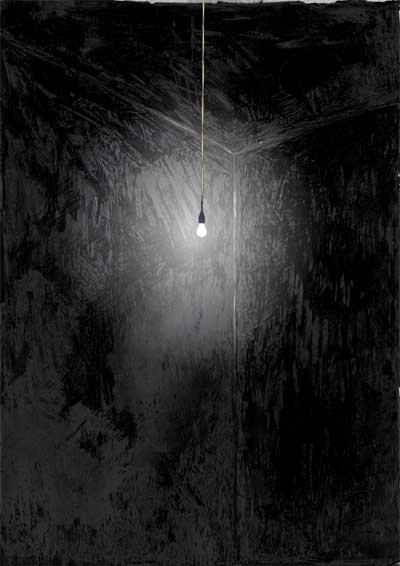
Int. Night, 2008
Lightjet c-print
131,5 x 95 cm framed, Unique

Chicken, 2008
Lightjet c-print
178 x 128 cm framed, Unique

Script for a film, 2008
Lightjet c-print
178 x 127,3 cm framed, Unique

Ass, 2008
Lightjet c-print
179 x 127,5 cm framed, Unique
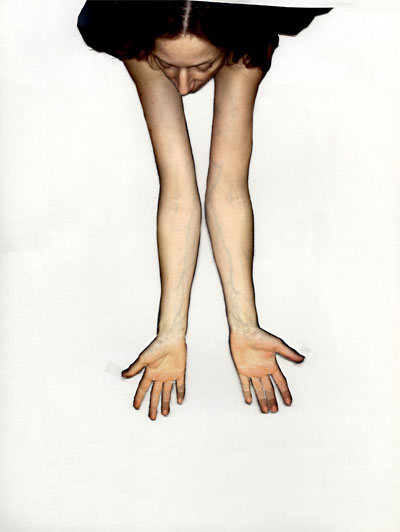
Untitled, 2008
Lightjet c-print
98 x 74,5 cm framed, Unique
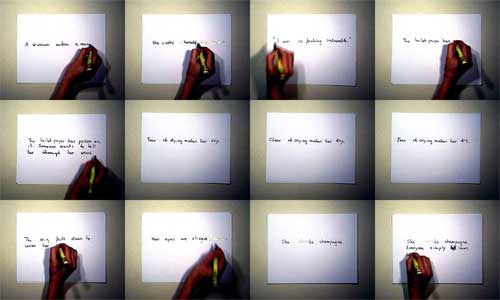
Script for a film, 2008
Video transferred to 16 mm film, colour/silent
3:00 min, Unique
Press Release
Vibeke Tandberg
A piece of me
Exhibition duration: 31 October – 19 December 2008
Klosterfelde Gallery and c/o – Atle Gerhardsen are extremely proud to
announce their second tandem exhibition with the Norwegian artist Vibeke Tandberg.
The title of both shows is "A Piece of Me", a song title from Britney
Spears' Album Blackout, which is about the media, and the pressure that the
singer endures under the scrutiny of the public eye. The title is not only
a reference to Britney Spears as a recurring motif, but also to the fact that,
as is often the case, Vibeke Tandberg herself is portrayed in most of her
works.
The central work at Klosterfelde is a floral wallpaper with a geometric pattern,
which on closer examination turns out to be a repeating composition of a paparazzo
picture of Britney Spears. It shows her sobbing as she leaves the courtroom
after losing custody of her two children: the key themes are exposure and
vulnerability – the singer is exposed to the media while mourning the
loss of her children and her suffering is mercilessly revealed to the entire
world.
The oversized collage works are selfportraits of Tandberg with a blond wig,
bearing certain resemblances to earlier works such as Line or Beautiful, in
which she investigated the issue of identity. In contrast to these digitally
modified works, in her current pieces, the artist is much more intrusive in
her images: she, for example, attaches the tormented face of a screaming baby
with a blond wig to the body of a porn star, or replaces her own profile with
that of an old lady or with the blood-smeared face of a young man. As in the
Britney Spears wallpaper, all of the collages deal with the juxtaposition
of exposing oneself and being exposed. It becomes clear that the vulnerability
resulting from the exposure is a universal feeling - shared by everyone who
is exposed. Interestingly enough, the old lady's profile or the blood-smeared
face were all found on the internet – the 21st century medium of mass-exposure.
The focal point at c/o – Atle Gerhardsen is formed by the 16 mm film
Script for a film (2008). This film was inspired by an unrealized sequence
from Maya Deren's film At Land (1944).
Script for a film is rendered in the form of a manuscript, which simultaneously
emerges -written with indecisive hand- as the spectator looks at the work.
The script evokes mental images, and can be understood as visible, changeable
prose. In Maya Deren's film a woman is washed up on a beach, and embarks on
a remarkable journey during which she must struggle to preserve her own personality.
The artist uses Deren's unused sequence, in which the main character is confronted
with her mirror image in the bathroom, as a kind of trigger for her own work.
From this point on in the movie, strange things start to happen. Tandberg
expands on this latent paranoia in Deren's film, providing a theatre of paranoid
mental images which are transmitted to the viewer in manuscript form, with
a play on the medium of writing. Script for a film is accompanied by a row
of photographs: small collage works were scanned in and enlarged with computer
technology. They form a kind of loose-hand storyboard for the film.
Vibeke Tandberg became known for her digital photo collages in the nineties.
The digital image processing opens up a simple way to question the possibility
of a truth claim in photography. Doppelgänger and twins, these primal
reproductions of the self, are included in a seemingly real world; masquerade
and changing identity are fostered by computer manipulation.
In 2005, Vibeke Tandberg decided that the scissors should no longer be confined
to a procedure on the computer; rather they have been included in the material
artistic production - as a tool. The monumental work "IHT September 29,
2004" (2005) was made in this way, later to be shown in a joint exhibition
with Klosterfelde and c/o – Atle Gerhardsen at Art Unlimited in Basel.
Vibeke Tandberg's current work combines both techniques.
Vibeke Tandberg (born 1967) lives and works in Oslo and Berlin. Her works
have been on display at numerous international exhibitions. Besides the parallel
solo exhibition openings at c/o – Atle Gerhardsen and Klosterfelde in
Berlin, the works of the artist are currently included in the group show "Ich
kann mir nicht jeden Tag ein Ohr abschneiden – Dekonstruktionen des
Künstlermythos” at Hamburger Bahnhof, Berlin (3 October 2008 –
22 February 2009), in “Reality Check - Contemporary Art from the mid-90s
to the Present” at the Statens Museum for Kunst, Copenhagen (6 September
2008 – 4 January 2009) and in the 28th Sao Paolo Biennial (26 October
- 6 December 2008).
–––––––––––––––––––––––
Vibeke Tandberg
A piece of me
Eröffnung: 31. Oktober 2008, 18 – 21 Uhr
Ausstellungsdauer: 31. Oktober – 19. Dezember 2008
c/o – Atle Gerhardsen und Galerie Klosterfelde freuen sich sehr, ihre
zweite Doppelausstellung mit der norwegischen Künstlerin Vibeke Tandberg
ankündigen zu dürfen.
Der Titel der beiden Ausstellungen “A Piece of Me” ist ein Liedtitel
von Britney Spears’ Album Blackout, in dem es um die Medien und um den
Druck, den die Öffentlichkeit auf die Sängerin ausübt geht.
Der Ausstellungstitel verweist nicht nur darauf, daß Britney Spears
ein immer wiederkehrendes Motiv ist, sondern auch auf die Tatsache, daß
Vibeke Tandberg selbst, wie so oft, auf den meisten der Arbeiten abgebildet
ist.
Die zentrale Arbeit bei Klosterfelde ist eine Tapete, auf deren blumenartig-geometrischem
Muster man bei genauerer Betrachtung ein immer wiederkehrendes Paparazzo-Photo
von Britney Spears erkennen kann. Es zeigt diese, als sie weinend das Gericht
verlässt, nachdem sie das Sorgerecht für ihre beiden Kinder verloren
hat: die beiden Themen Bloßstellung und Verletzlichkeit stehen im Mittelpunkt
- die Sängerin wird in ihrer Trauer um die verlorenen Kinder von den
Medien bloßgestellt und ihr Leid der Welt rücksichtslos präsentiert.
Die großformatigen Kollagearbeiten sind Selbstportraits von Tandberg
mit blonder Perücke, die durchaus an frühere Arbeiten wie Line oder
Beautiful erinnern, in denen sie dem Thema „Identität“ nachgeht.
Anders als bei diesen digital veränderten Werken, greift die Künstlerin
in ihrer jetzigen Werkgruppe noch stärker in ihre Bilder ein, indem sie
z.B. auf den Körper eines Pornostars das schmerzverzerrte Gesicht eines
schreienden Babys mit blonder Perücke setzt, oder indem sie ihr eigenes
Profil mit dem Profil einer alten Frau oder dem blutverschmierten Gesicht
eines jungen Mannes austauscht. Wie schon bei der Britney Spears Tapetenarbeit
geht es in den Kollagen um die Aspekte Selbstinszenierung und Bloßstellung.
Die aus der Bloßstellung resultierende Verletzlichkeit ist ein universelles
Phänomen – jeder kann sich damit identifizieren. Interessanterweise
stammen einige der Kollageelemente aus dem Internet – dem Medium der
Masseninszenierzung schlechthin.
Den Mittelpunkt bei c/o – Atle Gerhardsen bildet der 16 mm Film Script
for a film (2008). Dieser Film ist inspiriert von einer unrealisierten Sequenz
aus Maya Derens Film At Land (1944).
Script for a film ist in der Art eines Manuskriptes gehalten, das simultan,
während der Besucher die Arbeit betrachtet, mit unentschlossener Hand
geschrieben, entsteht. Das Script evoziert mentale Bilder und kann als sichtbar
gemachte, wandelbare Prosa verstanden werden. In Maya Derens Film wird eine
Frau an einem Strand angespült, sie geht auf eine seltsame Reise und
muß kämpfen, um ihre eigene Persönlichkeit wahren zu können.
Tandberg nutzt Derens unrealisierte Sequenz, in der die Hauptdarstellerin
im Badezimmer mit ihrem Spiegelbild konfrontiert wird, als eine Art Auslöser
für ihre eigene Arbeit, denn ab diesem Zeitpunkt geschehen im Film merkwürdige
Dinge. Die Künstlerin baut diese latent paranoide Atmosphäre in
Derens Film aus und liefert so ein Theater paranoider mentaler Bilder, die
sich dem Betrachter in Manuskriptform durch das Spiel mit dem Medium Schrift
vermitteln.
Script for a film wird begleitet von einer Reihe Fotografien: kleine Kollagearbeiten
wurden eingescannt und computertechnisch vergrößert. Sie dienen
als eine Art lockeres Storyboard für den Film.
Vibeke Tandberg wurde in den 1990er Jahren durch ihre digitalen Fotokollagen
bekannt. Die digitale Bildbearbeitung eröffnet auf einfache Weise die
Möglichkeit den Wahrheitsanspruch der Fotografie in Frage zu stellen.
Doppelgänger und Zwillinge, diese uralten Reproduktionen des Selbsts,
werden in eine real erscheinende Welt eingebaut, Maskerade und Identitätswechsel
durch Computermanipulation erzeugt.
2005 hat die Künstlerin begonnen, für ihre Kollagearbeiten die Schere
nicht nur als Arbeitsschritt am Computer zu nutzen, sondern sie als Werkzeug
tatsächlich in die künstlerische Produktion miteinzubeziehen. So
entstand die monumentale Arbeit IHT Sept. 29, 2004 (2005), die gemeinsam von
Klosterfelde und c/o – Atle Gerhardsen 2006 auf der Art Unlimited in
Basel gezeigt wurde. Die aktuellen Arbeiten von Vibeke Tandberg verbinden
beide Techniken.
Vibeke Tandberg (geboren 1967) lebt und arbeitet in Oslo und Berlin. Ihre
Werke sind auf zahlreichen internationalen Ausstellungen gezeigt worden. Neben
den beiden parallel eröffnenden Einzelausstellungen bei c/o – Atle
Gerhardsen und Klosterfelde in Berlin sind die Arbeiten der Künstlerin
zur Zeit auch in der Gruppenausstellung “Ich kann mir nicht jeden Tag
ein Ohr abschneiden”, Dekonstruktionen des Künstlermythos, im Hamburger
Bahnhof, Berlin (3. Oktober – 22. Februar 2008), in Reality Check. Contemporary
Art from the mid-90s to the present im Statens Museum for Kunst, Kopenhagen
(6. September 2008 – 4. Januar 2009) und auf der 28. Biennale von Sao
Paolo (26. Oktober - 6. Dezember 2008) zu sehen.